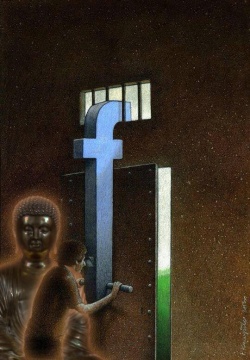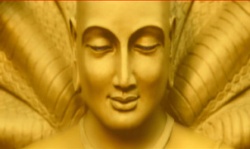Beginnings by Julia Hardy
Jump to navigation
Jump to search
- Buddhism evolved from the teachings of Siddhartha Gautama who was born in the 5th century B.C.E. (some scholars have argued for the 4th century B.C.E.) in the Indian state of Kapilavastu, now part of Nepal. Born a prince, the young man who would become the Buddha renounced a life of wealth and power, according to Buddhist texts, to become a spiritual seeker.
- After years of wandering and asceticism he became enlightened — that is, he had a realization about his own true nature. He saw that his own thinking was the only obstacle preventing the spiritual understanding he had been seeking.That obstacle was removed when he realized that his sense of himself as a separate and isolated individual was an illusion. He thus escaped from desire and suffering, and was called "The Buddha," or the Awakened One.
- In a deer park in the small town of Sarnath, outside modern Banaras, the Buddha preached his first sermon, in which he outlined four interrelated spiritual truths, often called the Four Noble Truths. These were: 1) that suffering is characteristic of human existence; 2) that suffering is caused by longing for pleasure and avoidance of pain; 3) that it is not necessary to suffer; and 4) that there is a path to end suffering. His sermons moved many who heard him speak and he began to gather disciples. These followers became the first sangha, or community of monks.
- At first, only men followed the Buddha as monks. Later, women were also allowed to become nuns, but with many restrictions reflecting the social customs of the time. According to Buddhist texts, the Buddha objected to this at first, but was persuaded by his disciple Ananda to admit women. Some of the early texts also suggested that women could not become enlightened, but must first be reborn as men. Feminist scholars of Buddhism believe that these stories are later additions to the texts that reflect attitudes toward women in those times.
- Some early Buddhist texts mention both men and women who, like the Buddha, became enlightened. The earliest disciples, called arhat, also attained enlightenment and were sent by the Buddha to wander and teach on their own. Soon there were many new converts and the new religion rapidly gained large numbers of followers.
- In the beginning, all of the Buddha's followers gave up home, family, social status, and possessions, and begged for their meals. They were taught that this was the way to become detached from material things and social status, which would hinder an individual's enlightenment. Sexual activity was also prohibited, as were intoxicants, comfortable seats or beds, and any form of entertainment. Monks were not allowed to handle money and were permitted only one meal a day.
- Those who appreciated the Buddha's teachings but were unable or unwilling to give up all their possessions and their social status supported the monks by providing food, clothing, and shelter. These lay followers were given five precepts: not to take human life, not to lie, not to steal, not to take intoxicants, and not to participate in illicit sexual activity. Their support earned them merit, which would facilitate rebirth as an individual who would be free to pursue spiritual goals.
- The Buddha allowed people of all castes, and those of no caste, to join the sangha.Many became monks, but lay people also joined in large numbers. Among these were people of low status as well as wealthy merchants and rulers.
- Although the first Buddhist monks were all wanderers, wealthy lay supporters soon began to donate land to the monks, originally for places to stay during the monsoon season and later for permanent dwellings and places for meditation and teaching. These became the first Buddhist monasteries. Soon this organization of itinerant monks had acquired, paradoxically, extensive holdings of land, which led to strict monastic rules about the use of this property, and which also led to some tensions between Buddhist monks and political rulers.
- The conversion of two powerful rulers also quieted some of the political wrangling. Converting to Buddhism accorded the rulers a higher religious status than they had held within the traditional caste system. The strict moral expectations of Buddhism also appealed to some rulers because it eased the burden of maintaining social stability. In turn, the Buddha expressed a vision of an ideal society in which selfless and fair rulers would distribute their wealth among the people.
- Within a few centuries after the Buddha's death, Chandragupta Maurya of Magadha would unite most of what is now called India into an empire. His grandson, Ashoka, converted to Buddhism a few years after he took the throne.At first Ashoka did not take his conversion seriously, but after leading a bloody conquest of the northeastern state of Kalinga, he experienced remorse and began to take Buddhism to heart. He decided to apply the Buddha's Dharma, or teachings, to his government and to spread the word of the Buddha throughout the empire and beyond. He erected dozens of huge stone pillars inscribed with basic Buddhist teachings, built monasteries, and created shelters for Buddhist pilgrims. Ashoka became the model for many subsequent rulers throughout Asia who affiliated themselves with Buddhism.


